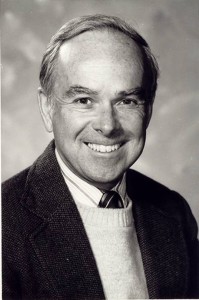Lawrence Piette
The Piette lecture series is named in honor of Lawrence Piette:
 Lawrence Piette (1932-1992)
Lawrence Piette (1932-1992)
A native of Chicago, Dr. Piette attended Northwestern University, where he was awarded Bachelor and Master of Science degrees in physical chemistry and published his first paper on kinetic methodology.1 In 1957 he completed his education with a Ph.D. in physical chemistry from Stanford. The title of his doctoral thesis was “Hindered Rotational Studies and Structural Determinations by NMR Techniques.” Dr. Piette accepted a position as a research chemist for Varian Associates, a scientific instrumentation company in Palo Alto, California in 1956. While at Varian in 1959, Dr. Piette published a highly cited article on potential energy barrier determinations by NMR.2 He published his first ESR investigation the same year, presumably attracted by the higher sensitivity of ESR. His 1959 publication was the first report of free radical metabolite formation by an enzyme peroxidase.3
In 1965, Dr. Piette assumed a position as full professor of biochemistry at the University of Hawaii. Shortly after the invention of spin labeling, Dr. Piette originated several much imitated experiments. The first was weakly- and strongly-immobilized spin-labeled sulfhydryl groups of erythrocyte ghosts.4 The second was the molecular “dip stick” applied to hapten-antibody binding to determine the “depth” of the combining site.5 The third was spin-labeling studies of protein active sites. In 1975, Dr. Piette performed the first in vivo ESR experiment using spin labels and a helix implanted in the liver of a rat.6
In 1972, Dr. Piette was awarded a Guggenheim Fellowship and spent a year in Paris and Grenoble developing novel biochemical applications of magnetic resonance spectroscopy. In 1977, Lai and Piette were the first to report the hydroxyl radical adduct of DMPO in a biological system.7 Hundreds of reports of this radical adduct in biology followed this work.
In 1984, Dr. Piette accepted a position as Dean of Graduate Studies and professor of biochemistry at Utah State University. While at Utah State University, Dr. Piette continued to define the forefront of research, investigating the nature of the hydroxyl radical-generating Fenton system in a highly cited 1990 publication.8 His untimely death from cancer in 1992 occurred shortly after he had helped to establish the National Center for the Design of Molecular Function.
A highly acclaimed researcher, Dr. Piette was also a skilled administrator. At the University of Hawaii, Dr. Piette held positions as Chairman for the Department of Biochemistry and Biophysics, President of the Faculty Senate, President of the American Association of University Professors and Executive Director of the Cancer Research Center of Hawaii. The Center, as one reporter wrote, was indeed “the house that Piette built.”
At Utah State, Dr. Piette served as the Associate Vice President for Research and Dean of Graduate Studies. During all of his academic tenure Dr. Piette was a strong advocate, supporter and mentor of graduate students and their research. Dr. Piette loved interacting with students and received some of his greatest pleasure helping them to achieve their graduate degree goals. Above all, he steadfastly upheld high ideals and a strong faith in basic scientific research.
We recognize Dr. Piette as a great scholar-administrator and a leading pioneer of biological ESR.
Selected Bibliography
1. R. G. Pearson and L. H. Piette: A Simple Steady State Method for Obtaining Rates of Rapid Reactions. J. Amer. Chem. Soc., 1954, 76, 3087.
2. L. H. Piette and W. A. Anderson: Potential Energy Barrier Determinations for Some Alkyl Nitrites by Nuclear Magnetic Resonance. J. Chem. Phys., 1959, 30, 899.
3. I. Yamazaki, H. S. Mason and L. H. Piette: Identification of Intermediate Substrate Free-Radicals Formed During Peroxidatic Oxidations by Electron Paramagnetic Resonance Spectroscopy. Biochem. Biophys. Res. Commun., 1959, 1, 336.
4. H. E. Sandberg and H. L. Piette: EPR Studies of Psychotropic Drug Interactions at Cell Membranes. Second International Symposium on Action Mechanism and Metabolism of Psychoactive Drugs Derived from Phenothiazines and Structurally Related Compounds. Agressologie, 1968, 9, 59.
5. J. C. Hsia and L. H. Piette: Spin-Labeling as a General Method in Studying Antibody Active Site: Arch. Biochem. Biophys., 1969, 129, 296.
6. A. Feldman, E. Wildman, G. Bartolini and L. H. Piette: In Vivo ESR in Rats. J. Phys. Med. Biol., 1975, 20, 602.
7. C. S. Lai and L. H. Piette, Hydroxy Radical Production Involved in Lipid Peroxidation of Rat Liver Microsomes. Biochem. Biophys. Res. Commun., 1977, 78, 51.
8. I. Yamazaki and L. H. Piette: ESR Spin-Trapping Studies on the Reaction of Fe2+ Ions with H2O2-Reactive Species in Oxygen Toxicity in Biology. J. Biol. Chem 1990, 265 3589
Past Piette Lecturers:
- 2016 – None
- 2015 – Tadeusz Sarna
- 2014 – Periannan Kuppusamy
- 2013 – David Cafiso
- 2012 – Ohara Augusto
- 2011 – Jeannette Vasquez-Vivar
- 2010 – Gary Gerfen
- 2009 – Paul Tordo
- 2008 – Neil Hogg
- 2007 – Michael Davies
- 2006 – Wayne Hubbell
- 2005 – Harold M. Swartz
- 2004 – Jay Zweier
- 2003 – Raman Kalyanaraman
- 2002 – Ron Mason
